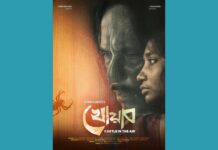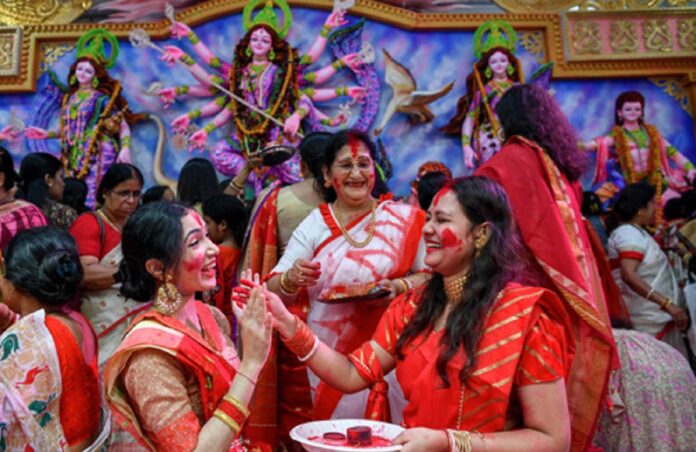The grand festival of five-day Sharadiya Durga Puja will come to an end tonight with celebrations of Sindur Khela in day time, immersion of idols in the evening at nearby rivers or ponds and exchanging Bijaya greetings among devotees across the country.
Temples across the country including Dhakeshwari National temple, Ramna Kali Temple, Siddheswari Kalimandir are now seeing massive gathering of female devotees clad in colorful dresses including white saree with red borders and they are performing Sindur khela, a significant part of Bijoya Dashami celebrations. Males also join this ritual nowadays with giving colors to faces of other devotees or participants.
Sindur Khela, literally meaning ‘vermillion game’, is a Hindu tradition of East India and Bangladesh where women smear each other with sindur on Bijaya Dashami, the last day of the Durga Puja.
On the day of after the conclusion of the ritual worship, married Hindu women apply sindur on the forehead and feet of the goddess and offer sweets to her. Then they put sindur on each other’s faces and offer sweets to each other, said Mahanagar Sarbajanin Puja Committee President Monindra Kumar Nath.
In the morning, Dashami puja was offered at temples and makeshift mandaps while Darpan Bisarjan will also be held before immersion of idols.
Darpan Bisarjan ceremony conducted on Bijaya Dashami day is the “real immersion” as it is beloved that the divinity that had been breathed into the Devi idol at installation, slowly leaves the idol, said purohit (priest) Sadhan Chakrabarty.
After the ritual, colourful processions to the riverside followed by Bisarjan or Niranjan of Devi idols are a spectacle to enjoy, he added.
Marking Dashami, colorful processions will be brought out from temples and makeshift puja mandaps and later Devi idols will be immersed in nearby rivers, ponds or water-bodies.
Bijaya Dashami is a bittersweet day as goddess Durga and her children are taken out of their earthly abode or the pandal for Bisarjan or immersion in the river.
This indicates her return to Mount Kailash. Devotees often shout “Aschhe bochhor abar hobe” (Durga Puja will return next year again).
In the past, the idols were carried on bamboo structures. However, nowadays the idols are transported in trucks or pickup vans to riverbanks and then they are placed in a boat and taken to the middle of the river for immersion.
After immersion of idols, young members of the family touch the feet of the elders to seek blessings. Some hug each other (kolakuli). Sweets such as chomchom, kalojam, sandesh, narkeler naru (mounds made of coconut and jaggery) are distributed on this day.
In the capital Dhaka, the main puja mandaps are at Dhakeshwari National Temple, Ramkrishna Mission and Math, Kalabagan, Banani, Shakhari Bazar and Ramna Kali Mandir.
In major divisional cities including port city Chattogram, Narayanganj, Rajshahi, Khulna and Sylhet and district towns including Faridpur, Dinajpur, Jashore, Kushtia, Netrakona, Tangail, Satkhira are also witnessing massive celebration of Durga Puja.
On Monday, Maha Navami, the fourth-day of Sharadiya Durga Puja, was celebrated with offering puja, anjali, daily bhog, sacrificing vegetables and fruits and dhunuchi nach (dance competition).
On Navami, Goddess Durga is worship as Mahisasuramardini which means the Annihilator of the Buffalo Demon. It is believed that on Maha Navami day Goddess Durga killed the demon Mahishasura.
Maha Navami is the penultimate day of Navratri, and it is dedicated to worshipping the goddess Durga, who is believed to have manifested her full divine power by this day. It is also the day when Durga is believed to have defeated the buffalo demon Mahishasura, symbolizing the triumph of good over
evil.
Last night, temples and makeshift pandals saw massive gathering of devotees and visitors as Navami is the last night of Sharadiyo Navaratri or Sharadiya Durgotsab.





























